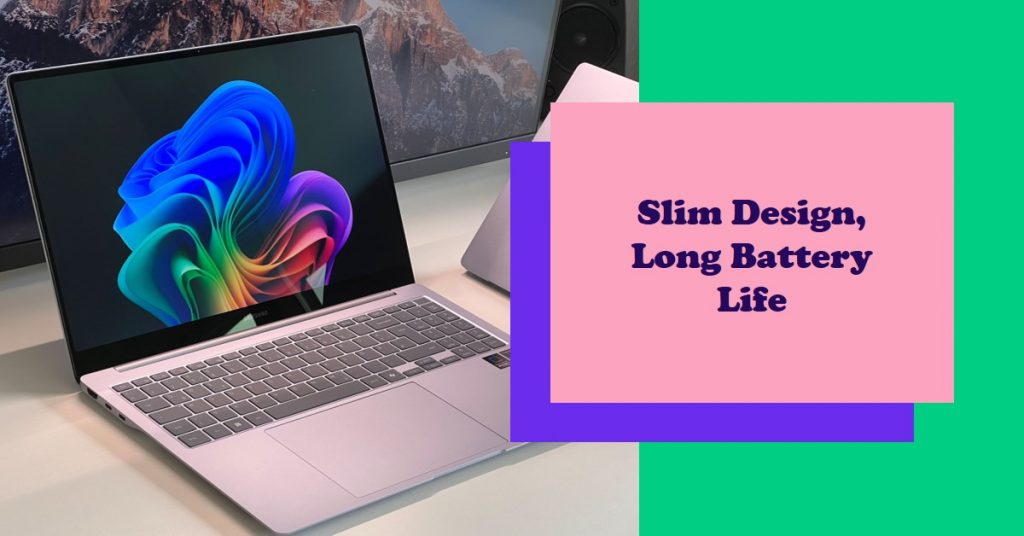The Samsung Galaxy Book Go promises a combination of affordability, portability, and a long battery life, making it an appealing choice for budget-conscious users or those within the Samsung ecosystem.

As a Windows-on-ARM laptop powered by the Qualcomm Snapdragon 7c Gen 2 processor, it aims to deliver light computing performance for everyday tasks like browsing, streaming, and document editing.
However, while it ticks off certain boxes like being lightweight and having a respectable battery, it lags behind when it comes to performance and display quality.
Before diving deeper into the various aspects of this laptop, here’s a quick look at its core specifications:
| Feature | Details |
|---|---|
| Processor | Qualcomm Snapdragon 7c Gen 2 |
| RAM | 4GB or 8GB |
| Storage | 64GB or 128GB eUFS |
| Display | 14-inch TFT, 1920×1080 resolution |
| Battery Life | Up to 12 hours |
| Weight | 3.04 pounds |
| Operating System | Windows 11 (upgradable) |
Key Specifications of the Samsung Galaxy Book Go
The Samsung Galaxy Book Go comes with a balanced yet basic configuration aimed at light users. Its Qualcomm Snapdragon 7c Gen 2 is an ARM-based processor, primarily designed for power efficiency. While it can’t match up to Intel or AMD counterparts in raw power, it delivers just enough for light productivity tasks, web browsing, and streaming.
The laptop offers either 4GB or 8GB of RAM, which is a limitation for anyone looking to multitask effectively. Storage options are limited to 64GB or 128GB eUFS, which may not be ideal for heavy users but can suffice for those storing most of their data in the cloud.
However, the standout specification is the battery life, which can last up to 12 hours depending on the usage. This makes it perfect for students or professionals who need their device to last through a full workday without constantly hunting for power outlets.
Design and Build Quality
Lightweight and Durable
When it comes to design, the Samsung Galaxy Book Go shines in terms of portability. Weighing just 3.04 pounds, it’s a featherweight laptop that you can easily toss into a backpack without feeling burdened. The 14-inch screen size also strikes a good balance between compactness and usability, offering a full laptop experience without being too bulky.
The design is sleek and minimalistic, featuring a silver matte finish that doesn’t easily show fingerprints. However, it’s important to mention that the overall build quality feels somewhat basic due to the plastic materials used. The bezels around the screen are noticeably thick, which detracts from the premium feel, but this is expected given its price point.
Keyboard and Touchpad Experience
The keyboard on the Galaxy Book Go is island-style, meaning the keys are separated, providing a decent typing experience. While the key travel isn’t the deepest, it’s still fairly comfortable for longer typing sessions. I managed to hit 90 words per minute with an accuracy rate of 99.7% during typing tests, which is better than average.
One downside, however, is the lack of backlighting. If you’re someone who frequently works in low-light conditions, this can be quite frustrating, as you’ll be left squinting to see the keys.
The touchpad, while spacious, doesn’t perform as reliably as I would like. There were instances where it became unresponsive, and I had to swipe repeatedly to get the cursor moving again. This inconsistency, while not a deal-breaker, does detract from the overall user experience.
Display and Multimedia
Mediocre Display Performance
The Samsung Galaxy Book Go is equipped with a 14-inch TFT display with a 1920×1080 resolution. While the display size is adequate for everyday tasks, the color accuracy is underwhelming. With a 42% DCI-P3 color gamut coverage, the colors appear washed out and lack the vibrancy that users would expect, even at this price point.
This becomes more noticeable if you’re doing anything beyond basic tasks—watching movies or editing photos, for instance. In comparison, budget alternatives like the Surface Go 2 offer significantly better display quality with a much higher color accuracy.
Audio Quality
Surprisingly, the audio quality is a bright spot for the Galaxy Book Go. The dual speakers deliver a better-than-expected sound experience. Whether listening to music or watching videos, the Dolby Access app allows for customizable sound profiles (Dynamic, Music, Movie, etc.), improving the overall sound performance.
I tested the speakers with Måneskin’s “Beggin’”, and the audio quality was balanced, with decent lows and highs. However, don’t expect room-filling volume, as the speakers tend to max out at moderate levels.
Performance and Usability
Snapdragon 7c Gen 2 Chip: Hits and Misses
The Qualcomm Snapdragon 7c Gen 2 processor is a mixed bag. On the positive side, it’s incredibly power-efficient, which is partly why the battery life is so impressive. However, in terms of raw performance, the Galaxy Book Go struggles. When using Google Chrome with more than a few tabs open, the system noticeably slows down. Basic multitasking, such as having Google Docs open alongside a few tabs, was challenging.
What’s more frustrating is the ARM architecture, which still faces software compatibility issues. For instance, Google Chrome isn’t optimized for ARM-based Windows devices and runs via an emulator, leading to noticeable performance degradation.
Multitasking and Productivity
While it’s not built for heavy multitasking, the Samsung Galaxy Book Go can handle light productivity tasks reasonably well. Microsoft Edge and Mozilla Firefox are more optimized for ARM, and using these browsers improves the experience.
In terms of software, Windows 11 runs smoothly for the most part, although the 64-bit processor does cause occasional slowdowns. If you plan to use resource-intensive applications like Adobe Photoshop Elements or run 3DMark for graphics testing, you’ll likely be disappointed as these programs struggled to perform well.
Competitors and Alternatives
If the Samsung Galaxy Book Go doesn’t seem like the right fit, here are a few alternatives worth considering:
- Microsoft Surface Go 2: This is a slightly more expensive alternative with a better display and superior stylus support, making it ideal for students and creatives.
- Chromebook Detachable CM3: Offers a significantly better display and a more portable form factor, but is limited by the Chrome OS environment.
- Dell Inspiron 15 3000: Provides a larger screen and a more traditional laptop experience but lags in terms of processor speed and portability.
Pros and Cons
H3: Pros
- Affordable: Great pricing for budget-conscious buyers.
- Decent Battery Life: Up to 12 hours on a single charge.
- Samsung Ecosystem Integration: Features like Link to Windows enhance productivity.
H3: Cons
- Poor Display: Limited color accuracy and brightness.
- Subpar Performance: Struggles with multitasking and heavier applications.
- Non-backlit Keyboard: Typing in low-light conditions can be challenging.
Final Verdict: Is the Samsung Galaxy Book Go Right for You?
The Samsung Galaxy Book Go is ideal for those who need a simple, portable laptop for basic tasks like web browsing, note-taking, and media consumption. Its long battery life and lightweight design make it a solid choice for students or frequent travelers. However, if you’re expecting more than basic performance or if you need a high-quality display, you might be better off exploring other options like the Surface Go 2 or a budget Chromebook.
Also Check:
- Amazon Next-Generation Echo Show 8 Review: How This Smart Display Reshaped My Home Setup
- Samsung Galaxy S24 Ultra vs Apple iPhone 16 Pro Max vs Google Pixel 8…
- PS5 Pro Review – Is Sony’s New Console Worth the Upgrade?
- Why Amazon Fire Stick 4K is the Best Budget 4K Streaming Solution
- Here’s What Alexa Emergency Assist Does and How to Set It Up
- Amazon Echo Spot 2024 Review: This Alexa-Powered Echo Spot Turned My Nightstand into a…
